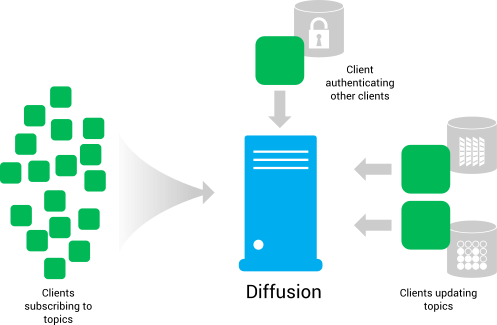Example: A solution using clients
Clients with different uses connect to the Diffusion™ server in this example solution.

- Clients subscribing to topics
- These clients are used by your customers to receive the data you distribute. You can use any of the provided APIs to create these, depending on how your customers want to access your data. For example,
- Use the Apple® API to create an iPhone app.
- Use the JavaScript® API to create a browser client.
These clients subscribe to the topics that are of interest to your customer, receive updates published on these topics, and display the information to your customers.
- Clients creating and updating topics
- These clients are used by your organization to distribute your data. You
must use an
API
that provides control features to create these clients.
For example, the
JavaScript
API
or the .NET
API
.
These clients create the topics required to support your data structure and to publish data from your data sources to topics on the Diffusion server .
- Clients authenticating other clients
- These clients are used by your organization to authenticate connections
from other clients. You must use an
API
that provides control features
to create these clients. For example, the
Java™
API
.
These clients are called by the Diffusion server to provide an authentication decision when another client connects to the Diffusion server anonymously or with a principal. In addition to deciding whether the other client is allowed to connect, the authenticating client can assign roles to the client session.
The authenticating client can use information stored elsewhere in your system, for example in an Lightweight Directory Access Protocol (LDAP) server, to make the authentication decision and assign roles.